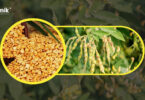Millet is widely grown in the world. It can tolerate drought, so it is more adopted in areas with less rainfall. India is the largest producer of millet. Along with human consumption, it is also used for animal feed. Its stalk is used to feed animals. Rajasthan, Maharashtra, Gujarat, Uttar Pradesh, Haryana, Madhya Pradesh, Karnataka, Andhra Pradesh, and Tamil Nadu are the main millet-producing states in India.
Soil –
It can be grown in many types of soil but grows well in sandy soil and well-drained soil. 6-7.5 pH is favorable for crop growth and development.
Popular Varieties and Yields
High tide –
SL44: Sweet, juicy, thin stem variety suitable for Kharif irrigated conditions across Punjab. Its average yield is 240 quintals per acre.
SL 45 (2022)(Single cut): Single-cut variety with tall plants (297 cm), broad leaves, and late maturity. Its stem is juicy and sweet. Its average yield is 271 quintals per acre.
Punjab Sudax Chari 4 (2015) (multi-cut): This is a hybrid sorghum variety that can be cut multiple times. Its average yield is 445 quintals per acre.
Punjab Sudax: It is a hybrid variety of jowar. A crop sown at the right time can be reaped thrice. This variety is resistant to red spot disease of leaves, and its average yield is 480 quintals per acre.
Millet –
KBH 108 (MH 1737): This variety is ready to harvest in 80-86 days.
MPMH 17: Ready to harvest in 79 days.
Avika Bajra chari: It is a dual-purpose variety. Its average green fodder yield is 15 tonnes and its grain yield is 4 quintals per acre.
86M86: This hybrid variety is suitable for late sowing and is ready to harvest in 80-85 days.
86M66: This hybrid variety is suitable for late sowing and is ready to harvest in 90 days.
Kaveri Super: This hybrid variety is suitable for late sowing and is ready to harvest in 80-85 days.
RHB 177: It is a drought-tolerant variety. Its average yield is 8-10 quintals per acre.
Raj 171: This hybrid variety is ready to harvest in 85 days. Its average yield is 8-10 quintals per acre.
Land Preparation –
Plough the field till the soil becomes loose. Plough twice in heavy and weed-infested soil. At the time of the last ploughing, mix 6 tonnes of cow dung in the soil.
Sowing Time –
The optimum time for sowing of jowar is from mid-June to mid-July. It is sown in the middle of March for early green fodder. The first fortnight of July is favourable for sowing Bajra.
Seed Rate–
Jowar:- Use 30-35 kg seed per acre for sowing.
Bajra:- Use 1.5-2 kg seed per acre according to the method of sowing.
Seed Treatment –
Sorghum:- To protect the crop from soil-borne diseases, treat the seeds with 300 mash, 4 grams of sulphur sawdust, and 25 grams of Azotobacter per kg of seeds before sowing.
Millet:- Thiram 3 grams or Chlorpyriphos 20 EC 4 ml to the seeds. per kg of seed treatment.
Fertiliser (Kg per acre) –
Jowar:- Urea – 44, SSP – 50 , MOP – 16
Bajra:- Urea – 75-87, SSP- 50-75, MOP- 16
Nutrients (kg per acre) –
Sorghum:- Nitrogen- 20-25, Phosphorous- 8, Potash- 10
Bajra:- Nitrogen- 35-40, Phosphorus- 8-10
Weed Management –
Keep the field clean and weed-free. After sowing Bajra, apply Atrazine @ 300 gm in 150 liters of water. Do pruning after 15-17 days of sowing and keep only a healthy crop.
Irrigation –
Sorghum:- For good yield, irrigate at the time of flowering and at the time of formation of grains. Sometimes irrigation creates critical situations. Irrigation can be done 1 to 3 times according to rainfall in Kharif. Irrigation should be done in the necessary conditions during rabi and summer. If there is a shortage of water, apply water before flowering and at the time of flowering.
Bajra:- It is a crop of rainfed area so it requires less irrigation. Give irrigation according to the intensity and regularity of rain. Do not allow water shortage at the time of ploughing, flowering and grain filling stage. Lack of water in these conditions causes serious loss in yield
Harmful pests and prevention –
Sorghum:- Stem borer- Spray Carbaryl 800 gm per acre to prevent it. Cabbage caterpillar- Spray 10 D 1 kg or Malathion 5 D 10 kg per acre. Earworm – Malathion 50 EC 400ml Mixing it in 200 liters of water, spray at 10% ear emergence.
Millet:- Blue bug: For the prevention of blue bug, 1.5 percent quinalphos 250 ml. Spray per acre. Root pest/Termite: If the attack of this pest is observed, sprinkle Methyl Parathion 2% @ 10 kg per acre.
Crop harvesting:-
The crop is ready for harvesting when the grains are hard and have the required moisture. Remove the spikelets from the standing crop with the help of a sickle.Some farmers cut the entire plant with sickle. Collect them after harvesting and keep the stem crop in open space and dry it for four-five days.
Storage/Post Harvest Management-
After drying thoroughly, thresh and separate the grains from the cobs. After that, clean the seeds. Sun dry the cleaned seeds and keep the moisture level at 12-14%. Fill the grains in gunny bags and store them in a dry place.








